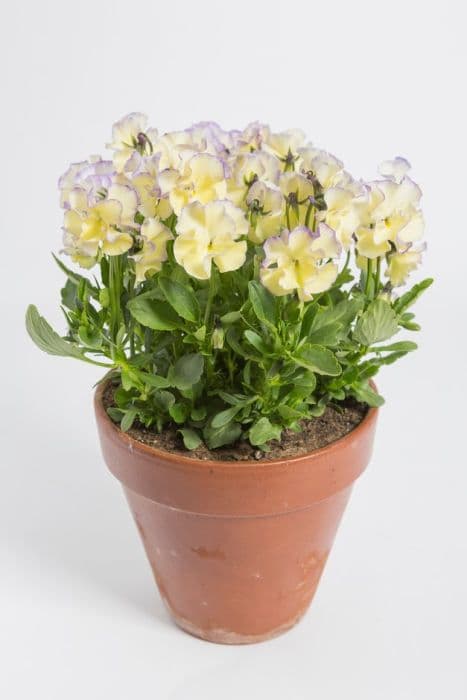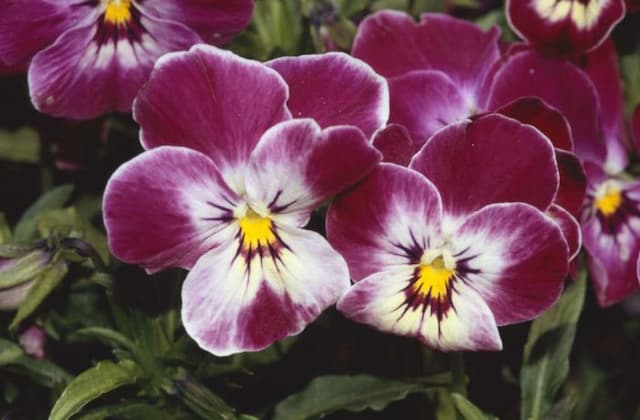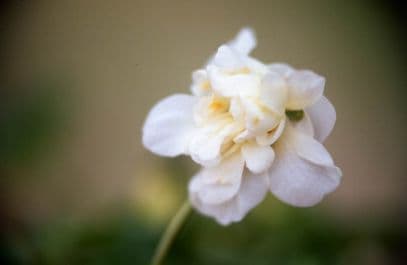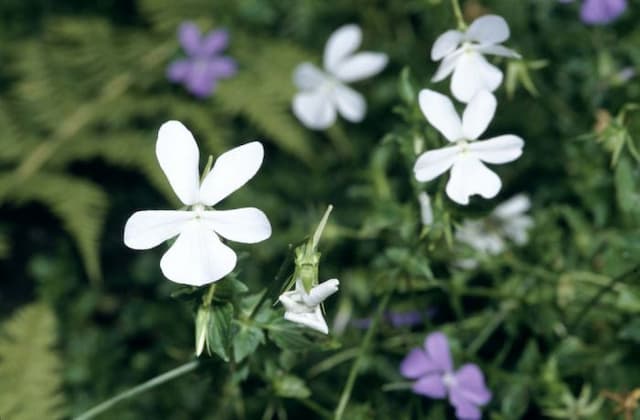Horned violet Viola cornuta

ABOUT
The plant commonly known as horned pansy or tufted pansy is a perennial plant characterized by its lush green foliage and charming flowers. Its leaves are typically heart-shaped with a slightly serrated edge and grow in a dense, mounded form. The notable flowers of this plant boast a distinctive horn-like spur, which gives the plant its common name. These blooms come in a variety of colors, including purple, blue, yellow, white, and even multicolored petals that may have intricate patterns or delicate veining. The flowers typically have five petals; the lower petal directs to the spur, the lateral ones are often bearded with fine hairs, and the upper pair may show darker color zones which add depth to the bloom's appearance. The horned pansy blooms prolifically, covering the plant with a blanket of cheerful color that can be a vibrant addition to garden beds, borders, or containers.
About this plant
 Names
NamesSynonyms
Horned Violet, Horned Pansy, Tufted Pansy.
Common names
Viola cornuta var. alba, Viola cornuta var. bicolor, Viola cornuta var. lutea, Viola cornuta var. nanum, Viola cornuta var. perennis, Viola tricolor var. cornuta.
 Toxicity
ToxicityTo humans
Horned violet is generally considered non-toxic to humans. There are no well-documented cases of poisoning from eating any part of this plant. However, as with any plant consumption, individuals may have varying sensitivities or allergic reactions. It is always best to exercise caution and avoid eating plants not specifically grown for consumption.
To pets
Horned violet is also generally considered non-toxic to pets. There is no significant evidence to suggest that it poses a risk of poisoning to pets such as cats and dogs. As with humans, individual pets may have different sensitivities, and it is always best to prevent pets from consuming plants that are not intended as food to avoid any potential adverse reactions.
 Characteristics
CharacteristicsLife cycle
Perennials
Foliage type
Evergreen
Color of leaves
Green
Flower color
Varies
Height
6-10 inches (15-25 cm)
Spread
6-12 inches (15-30 cm)
Plant type
Herb
Hardiness zones
4-9
Native area
Spain
Benefits
 General Benefits
General Benefits- Ornamental Appeal: Viola cornuta, commonly known as horned pansy, has vibrant flowers that add color and visual interest to gardens and landscapes.
- Extended Blooming Period: Horned pansies have a long flowering season, often from spring through fall, providing a consistent display of beauty.
- Low Maintenance: They are relatively easy to care for, requiring minimal upkeep beyond regular watering and occasional feeding.
- Attracts Pollinators: The flowers attract butterflies and bees, supporting pollinator populations and biodiversity in the garden.
- Edible Flowers: The blooms are edible and can be used in salads, desserts, or as garnishes, adding a unique touch to culinary creations.
- Container Gardening: Suitable for pots and containers, they are ideal for balconies, patios, or small garden spaces.
- Ground Cover: Their dense growth habit can help suppress weeds and cover bare spots in the garden.
- Versatility in Landscaping: They can be used in a variety of garden settings, including borders, rock gardens, and as underplanting for taller plants.
- Breeding Programs: Horned pansies are used in breeding programs to develop new varieties of pansies with different colors and patterns.
 Medical Properties
Medical Properties- Anti-inflammatory: Viola cornuta is used in traditional medicine for its potential anti-inflammatory properties.
- Expectorant: The plant is believed to have expectorant properties that may help in relieving respiratory conditions.
- Diuretic: It is sometimes used for its diuretic effects to help increase urine output.
- Antirheumatic: The plant has been used to relieve rheumatic pain in some traditional healing protocols.
 Air-purifying Qualities
Air-purifying QualitiesThis plant is not specifically known for air purifying qualities.
 Other Uses
Other Uses- Garnish and Edible Decorations: The flowers of the Horned Pansy can be used to add a splash of color and a delicate, lightly sweet flavor to salads, desserts, and other culinary presentations.
- Natural Dyes: The blooms can be used to create natural dyes for fabric or paper, providing hues ranging from soft yellows to greens depending on the mordant used.
- Photography: Horned Pansy’s vibrant colors and patterns make them an excellent subject for macro and nature photography, serving as a tool for artists and hobbyists.
- Floral Arrangements: The flowers can be used in bouquets and displays, either fresh or dried, to provide long-lasting color indoors.
- Educational Use: These plants can serve as an educational tool for botany classes, illustrating plant growth, flower structure, and pollination.
- Aromatherapy: While not a traditional aromatherapy plant, the Horned Pansy can contribute a mild, pleasant scent to potpourris or homemade scent sachets.
- Companion Planting: When planted in vegetable gardens, Horned Pansies can attract pollinators which in turn helps to increase the yield of fruit and vegetable crops.
- Perfumery: Although not commonly used in perfumery, the subtle fragrance of Horned Pansy can inspire perfumers in creating new scents.
- Handicrafts: Craft enthusiasts may use dried Horned Pansy flowers to create bookmarks, candles, or soap inclusions for added beauty and interest.
- Soil Indicator: Horned Pansies can sometimes be used as bio-indicators of soil health or pH, as they may exhibit signs of stress or discoloration when growing conditions are not optimal.
Interesting Facts
 Feng Shui
Feng ShuiThe Horned Violet is not used in Feng Shui practice.
 Zodiac Sign Compitability
Zodiac Sign CompitabilityThe Horned Violet is not used in astrology practice.
 Plant Symbolism
Plant Symbolism- Modesty: Because the Viola cornuta often has small and unassuming flowers, it is commonly associated with the virtue of modesty.
- Innocence: The delicate appearance of its blooms leads to a symbolic connection with purity and innocence.
- Love: In the language of flowers, violas often signify affectionate thoughts and love, possibly due to their heart-shaped leaves.
- Remembrance: The perennial nature of the Horned Viola suggests the theme of remembrance, as it returns each spring.
- Humility: Similar to modesty, the humble appearance of the plant makes it a symbol for humility.
 Water
WaterHorned violets should be kept evenly moist without being waterlogged. Watering should be done deeply once or twice a week, depending on weather conditions, ensuring that you apply around 1 gallon per square foot every week. During hot, dry spells, the frequency may increase to maintain the soil's moisture. Always water at the base of the plant to avoid wetting the foliage, which can lead to fungal diseases. Reduce watering in the winter months when the plant is not growing actively.
 Light
LightHorned violets thrive best in partial shade to full sun. They prefer bright conditions but should be protected from the intense, direct afternoon sunlight especially in hotter climates. A spot that gets morning sunlight and dappled shade in the afternoon would be ideal for these plants.
 Temperature
TemperatureHorned violets perform well in cooler temperatures and can tolerate a range from 40°F to 65°F, which are ideal growing conditions. They can survive light frosts and temperatures slightly below freezing, but extended periods below 20°F may damage the plant.
 Pruning
PruningHorned violets benefit from regular deadheading to encourage continuous blooming and prevent self-seeding if not desired. Prune off spent flowers and any damaged or dead leaves as needed. The best time to prune for shaping or to rejuvenate the plant is in the early spring or after a flush of blooming has finished.
 Cleaning
CleaningAs needed
 Soil
SoilHorned pansy (Viola cornuta) thrives best in moist, well-draining soil enriched with organic matter such as compost. A mix of potting soil, peat moss, and perlite or vermiculite can create an ideal growing environment. The soil pH should be slightly acidic to neutral, ranging from 6.0 to 7.0.
 Repotting
RepottingHorned pansy typically does not require frequent repotting and can often be left for several years without being disturbed, except to divide if they become too crowded.
 Humidity & Misting
Humidity & MistingHorned pansy prefers moderate humidity levels but is quite adaptable and does not require any special atmospheric humidity adjustments to grow healthy.
 Suitable locations
Suitable locationsIndoor
Place horned pansy in bright, indirect light indoors.
Outdoor
Plant horned pansy in part sun to full shade outdoors.
Hardiness zone
4-8 USDA
 Life cycle
Life cycleThe life of Viola cornuta, commonly known as horned pansy or horned violet, begins with seed germination, which typically occurs in spring or fall when temperatures are mild. After germination, the seedlings develop into rosettes of heart-shaped leaves, with roots establishing in the soil. As the plant matures, it produces stems that bear the distinctive flowers, usually in shades of purple, blue, or white with contrasting markings. The flowers are hermaphroditic, containing both male and female reproductive structures, and can self-pollinate or be pollinated by insects to produce seeds. After pollination, the flowers develop into small capsules containing numerous seeds. Once mature, these seeds are dispersed, often by wind or water, to begin the cycle anew.
 Propogation
PropogationPropogation time
Spring to Summer
Propogation: For the Horned Violet, which is commonly referred to as Viola cornuta, the most popular method of propagation is by seed. The optimal time for sowing these seeds is late winter to early spring. Starting the seeds indoors approximately 10 to 12 weeks before the last frost date is ideal. You should use a seed starting mix and lightly cover the seeds with soil as they require darkness to germinate. Maintain a consistent moisture level and a temperature of about 65 to 70°F (18 to 21°C). The germination can be slow and uneven, sometimes taking 2 weeks to a month. After seedlings develop true leaves and danger of frost has passed, they may be hardened off and transplanted outdoors to enjoy throughout the growing season.









